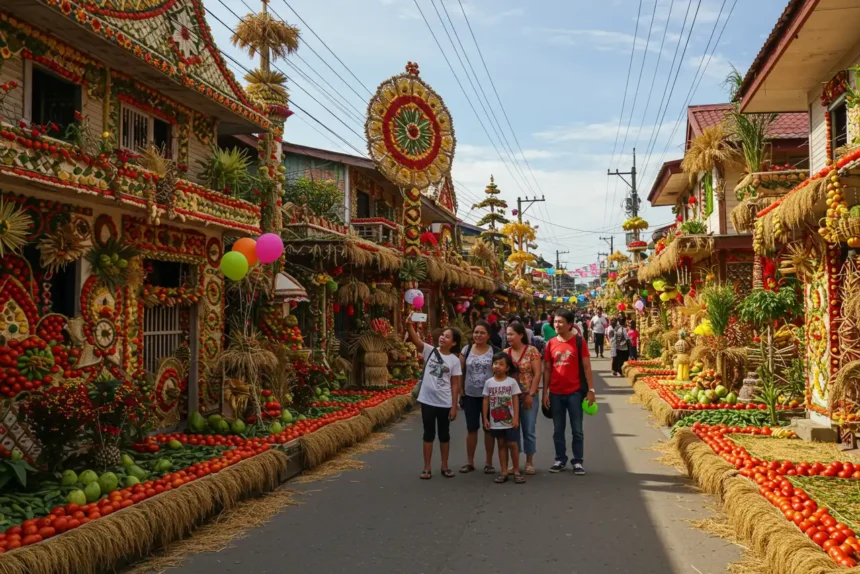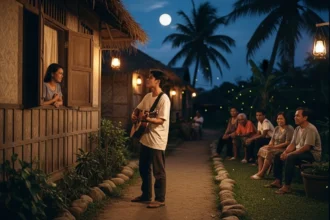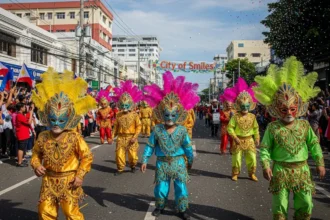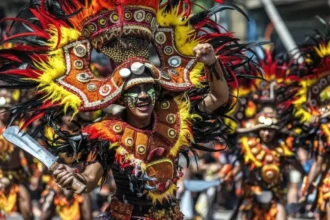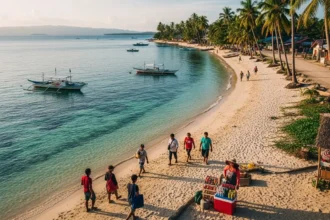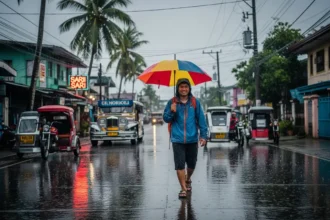Every May, the quiet town of Lucban, Quezon bursts into a dazzling display of color, creativity, and faith during the Pahiyas Festival – one of the Philippines’ most iconic harvest celebrations.
Homes transform into works of art decorated with kiping (rice wafers), fruits, vegetables, and native crafts – each one a heartfelt offering to San Isidro Labrador, the patron saint of farmers. Streets overflow with smiling locals, tourists snapping photos, and the smell of longganisang Lucban grilling in the air.
Whether you’re coming for the stunning house designs, the festive parade, or the mouthwatering food, this guide will help you plan your Pahiyas Festival 2026 trip like a pro – from the exact schedule to travel hacks and local secrets straight from Lucban’s friendly residents. 🌸
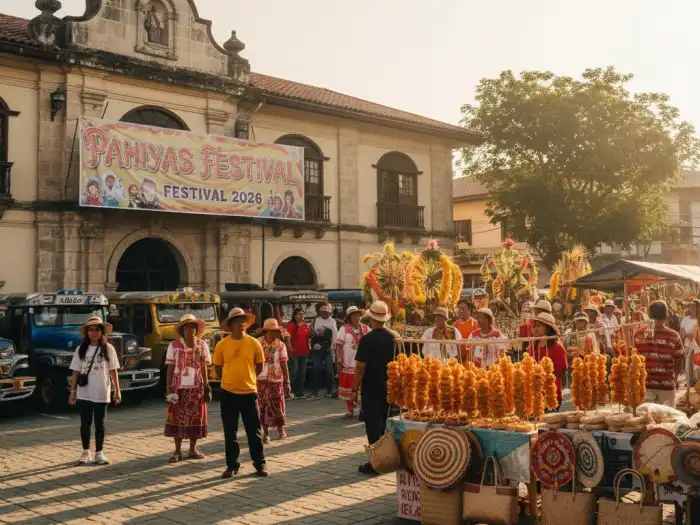
📅 2026 Schedule & Key Events
Every May 15, the town of Lucban, Quezon becomes a living canvas of color, devotion, and creativity. The Pahiyas Festival – held in honor of San Isidro Labrador, the patron saint of farmers – is both a thanksgiving for a bountiful harvest and a showcase of Filipino artistry.
In 2026, the celebration will once again draw thousands of visitors eager to witness streets lined with houses decked in kiping, rice grains, fruits, vegetables, and handmade ornaments. It’s an explosion of texture and color that feels almost unreal – every home competing to outshine the next, not for vanity, but for gratitude.
While most activities revolve around the main festival day, the Lucban local government usually holds pre-events starting a week before. Here’s what you can expect for Pahiyas Festival 2026 (based on the town’s recurring program schedule):
| Date (Tentative) | Event / Activity | What to Expect |
|---|---|---|
| May 8–14, 2026 | Pre-Pahiyas Exhibits & Trade Fair | Local artists and farmers display products like kiping crafts, handicrafts, and Quezon delicacies at Lucban Municipal Grounds. |
| May 14, 2026 | Pahiyas Eve (Decorating Day) 🎨 | Residents decorate their homes through the night with rice wafers, vegetables, and fruits. Streets come alive with color and anticipation. |
| May 15, 2026 | Main Festival Day & Grand Procession 🚶♂️ | The image of San Isidro Labrador is paraded through decorated streets, blessing each home. Expect cultural shows, live music, and traditional food stalls. |
| May 15, 2026 (Evening) | Awarding of Best Decorated Houses 🏆 | The most creative homes receive recognition and prizes – from simple native huts to full-on architectural masterpieces made of kiping. |
| May 16, 2026 | Post-Festival Fiesta & Food Fair 🍽️ | Locals celebrate with shared meals, dancing, and final street performances. A great day for quieter exploration and photo ops. |
🏡 Local Tradition Note – The Blessing of Homes
As the procession passes, each house receives a blessing from the priest carrying the image of San Isidro. Locals believe this brings prosperity and protection for the year ahead. Visitors are encouraged to watch respectfully – or join the prayers if you wish to experience the deeper meaning of Pahiyas.
🧺 Traveler’s Move – Where to Stay and When to Book
Lucban is a small town, so accommodations are limited and fill up months ahead. Book your stay by March 2026 if you want to be near the parade routes or the town plaza. Nearby Lucena City (30 minutes away) also offers hotels with easier availability and day-trip convenience.
For the best experience, arrive on May 14 to watch locals decorating their homes – it’s a sight many miss but one of the most authentic parts of the celebration.
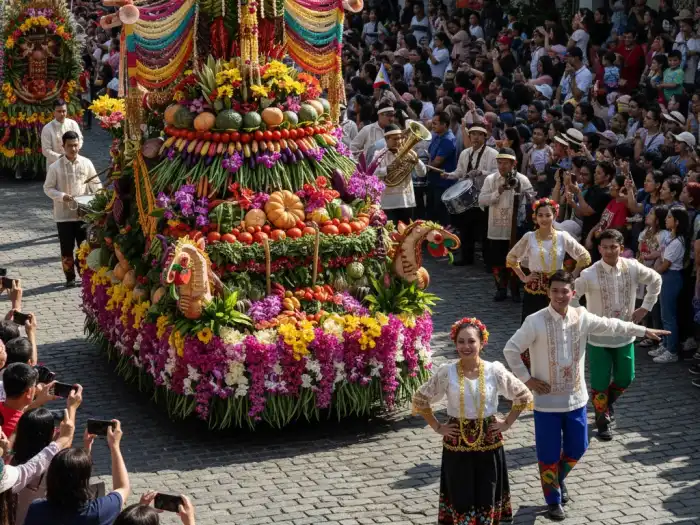
🎨 Festival Highlights & Cultural Attractions
No other festival in the Philippines turns an entire town into a giant open-air gallery quite like Pahiyas Festival. Every house, every street, and every smiling face becomes part of the masterpiece. It’s a day where faith meets creativity – and Lucban transforms into a living painting of gratitude.
🏠 The Famous Decorated Houses
The soul of Pahiyas lies in its house decorations – a tradition that’s been passed down for generations. Locals go all out, covering their façades with rice grains, corn husks, vegetables, and most famously, kiping – colorful leaf-shaped wafers made from rice paste.
Each house tells its own story. Some use bright floral patterns, while others form intricate religious icons or massive murals made entirely of kiping. The process takes weeks of planning and hours of teamwork – neighbors helping neighbors, families staying up all night just to make sure every detail shines.
Local Hack – Catch the Early Glow
The best time to see the houses is early morning (6:00–9:00 AM) before crowds fill the streets and the midday sun starts to fade the colors. Locals are usually happy to let you take photos in front of their homes – just ask politely and smile!
🍃 The Art of Kiping
Kiping is the festival’s signature art form – colorful rice wafers shaped like leaves and dried under the sun. It’s both beautiful and symbolic: a representation of the people’s reliance on rice as a gift of the land.
During the festival, kiping is used not only for decorating houses but also as hanging ornaments, floral arches, and chandeliers known as kiping chandeliers. In the evening, the colors reflect off warm lights, turning the streets into a glowing mosaic.
Making kiping is an art of patience. Locals grind rice into a fine paste, mix it with water and food coloring, then steam it over banana leaves. Once dried, it’s light, translucent, and surprisingly edible – though a bit chewy!
Cultural Gem – Try the Kiping Chips
Vendors often fry kiping into crunchy snacks topped with sugar or cheese. Grab a bag while you explore – it’s Lucban’s colorful version of street popcorn.
🎭 The Grand Parade & Religious Procession
The procession of San Isidro Labrador is the heart of Pahiyas Day. The saint’s image, carried through the streets on a float adorned with flowers and vegetables, stops by each decorated home to bless the harvest.
As the parade passes, brass bands play traditional music, students perform folk dances, and locals wave banderitas (colorful flags). The air is filled with laughter, prayers, and that distinct mix of faith and fiesta that makes Lucban so special.
Tourists line up along Regidor Street and Rizal Avenue, where most of the parade passes. Locals toss candies, snacks, or vegetables from their homes to symbolize sharing abundance.
Traveler’s Secret – Parade Viewpoint
For great photos, find a spot near Lucban Church – this is where the floats slow down, giving you a clear shot of the saint, performers, and the vibrant crowd.
🍽️ The Flavors of Lucban
After hours of exploring, nothing beats Lucban’s famous food. The festival doubles as a culinary celebration, with stalls overflowing with local favorites:
- Longganisang Lucban – garlicky and slightly sour sausages grilled to perfection.
- Pancit Habhab – noodles served on banana leaves, eaten without utensils (just slurp and smile).
- Lucban Hardinera – a baked meatloaf-style dish, colorful and hearty.
- Kiping snacks and rice cakes – sweet treats sold in every corner.
Foodie Tip – Eat Street Style
Skip the restaurants on May 15 – the real flavors are in the streets. Locals set up grills and food carts right outside their homes. Bring small bills and an appetite!
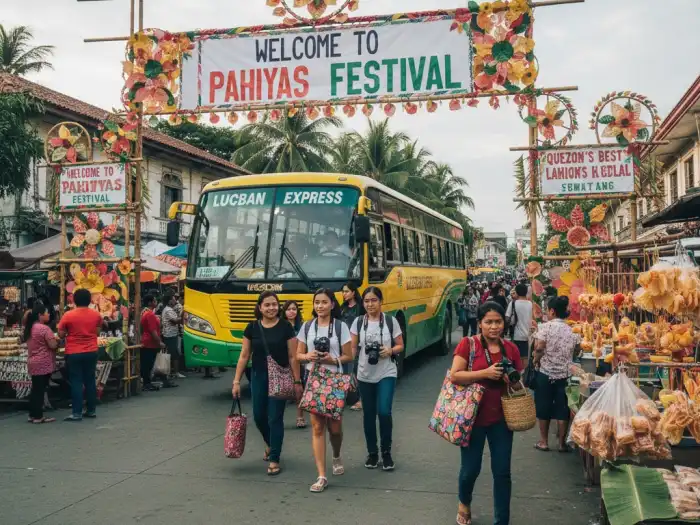
🧭 How to Get There & Travel Tips
The town of Lucban, Quezon may be small, but during Pahiyas Festival 2026, it feels like the center of the Philippines. Streets overflow with tourists, vendors, and photographers – all eager to witness the country’s most colorful harvest celebration. Getting there is half the adventure, especially if you’re coming from Manila or nearby provinces.
🚗 How to Go to Lucban
| Route | Travel Time | Details & Tips |
|---|---|---|
| From Manila (Private Car) | 3–4 hours | Take South Luzon Expressway (SLEX) → Exit Calamba → follow Maharlika Highway to Lucena → then to Lucban. Roads get narrow near town, so leave early (around 4–5 AM). |
| From Manila (Bus) | 4–5 hours | Ride a Lucena-bound bus (JAC Liner, DLTB, JAM) from Buendia or Cubao (₱300–₱400). From Lucena Grand Terminal, ride a jeepney or van to Lucban (₱50–₱70). |
| From Laguna or Batangas | 2–3 hours | If you’re near San Pablo, take the Nagcarlan–Liliw–Lucban route. Scenic, with views of Mount Banahaw and local fruit stands along the way. |
Timing Trick – Beat the Morning Rush
Lucban’s narrow roads can turn into a parking lot by 9 AM. Aim to arrive before sunrise (around 6 AM) on May 15 to catch the town waking up to the festival glow.
🏨 Where to Stay During Pahiyas
Lucban’s charm lies in its small-town vibe – which means accommodations are limited and book fast. Plan months ahead, especially if you want to stay inside the town proper.
| Area | Best For | Budget Range (per night) |
|---|---|---|
| Lucban Town Proper | Walking distance to parade routes & church | ₱3,000–₱6,000 |
| Lucena City | More hotel options, 30-min away | ₱2,000–₱4,500 |
| Tayabas or Sariaya | Quieter stays, access to nearby attractions | ₱1,200–₱3,000 |
| San Pablo (Laguna) | Great for day trips & nature resorts | ₱2,000–₱4,000 |
Local Hack – Stay with a Local
Some Lucban families open their homes to guests during the festival. Check Facebook travel groups or Airbnb listings by March for homestay offers. You’ll experience authentic hospitality – plus home-cooked longganisa for breakfast.
🕐 Best Time to Visit
The main festivities happen on May 15, but it’s best to arrive a day before (May 14) to see locals decorating their houses. If you want less crowd, come on May 16, when the decorations are still up but the parade rush is over – perfect for photography and quiet exploration.
🎒 What to Pack
Lucban’s May weather is warm and humid, with a mix of sunshine and quick afternoon showers. Here’s what to bring:
✅ Light, breathable clothes
✅ Hat or cap for shade
✅ Portable fan or mini towel
✅ Power bank and camera
✅ Cash (some stalls don’t accept digital payment)
✅ Small umbrella or rain poncho
✅ Eco-bag for souvenirs and kiping snacks
Traveler’s Secret – Bring Extra Patience & Curiosity
The streets get packed and the crowd moves slow – but that’s part of the charm. Talk to vendors, taste local food, and admire the houses up close. Every corner has a story if you take the time to listen.
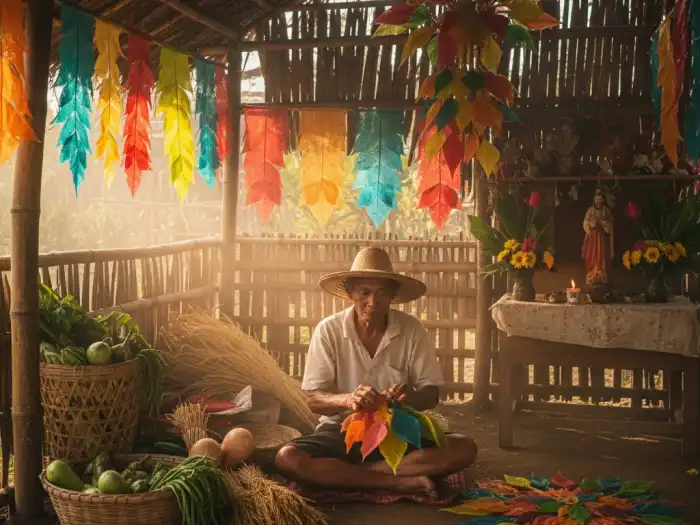
🌾 Pahiyas History & Cultural Significance
Every bright kiping leaf and hanging vegetable in Lucban’s Pahiyas Festival carries centuries of devotion and gratitude. Before it became a national spectacle, Pahiyas was simply a humble alay – an offering of harvest to San Isidro Labrador, the patron saint of farmers.
🙏 From Simple Offering to Grand Tradition
The roots of Pahiyas date back to the 16th century, when Spanish friars introduced the tradition of blessing crops to ensure abundant harvests. Farmers would bring their best produce to the church as an offering, believing that sharing blessings brings more blessings.
As years went by, the ritual evolved. When offerings grew too many to fit inside the church, the priests decided to bless them outside – right on the doorsteps of people’s homes. That small adjustment eventually became the foundation of what we now know as Pahiyas.
Locals began decorating their houses with rice, fruits, vegetables, and grains to show gratitude for the year’s harvest – and to catch the priest’s blessing as the procession of San Isidro Labrador passed by. Over time, creativity flourished, and competition naturally followed – until the whole town turned into a breathtaking tapestry of color and craftsmanship.
Cultural Note – “Payas” Means to Decorate
The word Pahiyas comes from the Filipino root word “payas”, which means to decorate or adorn. The festival’s name itself reflects the spirit of beauty, faith, and abundance shared by Lucban’s people.
🎨 The Spirit of Creativity and Faith
What makes Pahiyas special is how it merges art and agriculture – two worlds that rarely meet but coexist perfectly in this town. Every house becomes a symbol of Filipino ingenuity, proving that even with simple materials, creativity knows no bounds.
Families work together for weeks crafting designs out of rice husks, leaves, and bamboo. Each home is unique, yet all share the same message: Salamat sa biyaya. (Thank you for the blessings.)
The festival isn’t just about color or spectacle – it’s a reminder that behind every grain of rice is the hard work of Filipino farmers and the faith that sustains them through every season.
Local Wisdom – “Kung saan may pasasalamat, may kasiyahan.”
(Where there is gratitude, there is celebration.) That’s the true heart of Pahiyas.
🌸 From Local Devotion to National Treasure
In 1963, Pahiyas was officially recognized by the Department of Tourism as one of the country’s top cultural festivals. Since then, it has drawn both local and foreign tourists, becoming a proud symbol of Quezon Province’s artistic and agricultural heritage.
Despite its fame, the people of Lucban have kept its soul intact. Every year, they decorate not for the cameras, but for San Isidro – as their ancestors did.
So while the festival dazzles outsiders with its color, its deeper message remains simple: gratitude, creativity, and community.
And that’s why Pahiyas isn’t just seen – it’s felt. 🌾
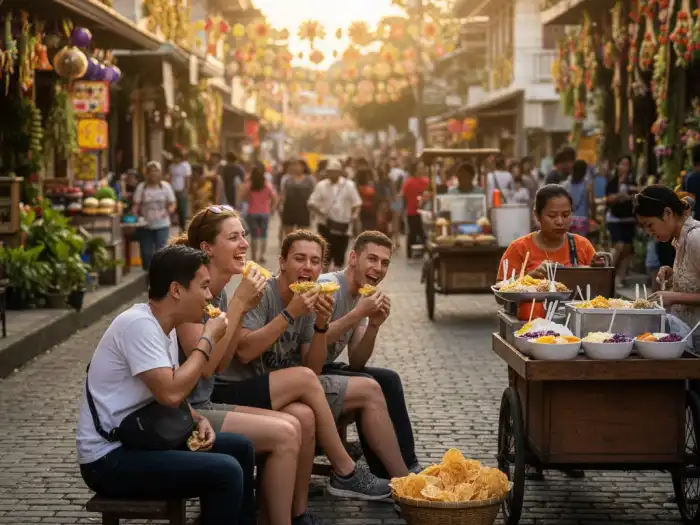
💡 Travel Hacks & Local Tips for First-Timers
The Pahiyas Festival is one of those once-in-a-lifetime fiestas every Filipino should experience. But between the crowd, the heat, and the overwhelming beauty of it all, it helps to know a few smart moves before diving into the celebration.
🕕 Arrive Before the Parade
Lucban’s streets start filling up as early as 6 AM on May 15. If you want to see the decorated houses in full glow and enjoy cooler air, come the night before (May 14) and wake up early. That’s when locals are still making last-minute touches – and the town feels alive but calm.
Timing Trick – Sunrise Magic
The early morning light makes kiping decorations glow like stained glass. It’s the best time for photography – and for tasting freshly grilled longganisa from roadside stalls before the crowd swells.
📸 Find the Best Photo Spots
Every street in Lucban is a photo op waiting to happen, but a few areas stand out:
| Location | Why It’s Great |
|---|---|
| Lucban Church (San Luis Obispo Parish) | Heart of the festival and the starting point of the procession. |
| Regidor Street | Densely decorated homes and most competition entries. |
| Rizal Avenue | Wider street, great for capturing parades and floats. |
| Barangay Tiawe & Barangay Silangang Mayao | Often overlooked but filled with creative displays. |
Traveler’s Secret – Respect the Displays
Never touch or lean on the decorations – most are fragile, made of rice paste or dried leaves. Locals take great pride in their work, and a little respect goes a long way.
💰 Budget Tips for the Thrifty Traveler
Lucban is affordable even during festival season. You can enjoy a full Pahiyas weekend for under ₱3,000–₱4,000 if you plan right.
| Expense | Estimated Cost |
|---|---|
| Transportation (round trip from Manila) | ₱700–₱1,000 |
| Lodging (1 night, homestay or pension house) | ₱1,500–₱2,500 |
| Food & drinks | ₱800–₱1,200 |
| Souvenirs & extras | ₱500–₱800 |
| Total Estimate | ₱3,000–₱4,500 |
Budget Move – Eat Local, Skip Fancy
Head to Eker & Ely’s Lucban Longganisa or Patio Rizal for affordable meals. Street vendors also sell Lucban pancit and kiping snacks – ₱50 can already fill your belly.
🚶 Navigate the Festival Like a Local
Lucban’s streets get packed tight, especially by midmorning. Cars are banned from the main roads on May 15, so wear comfy shoes and prepare to walk a lot.
Local Hack – Know the Side Streets
Use alleys near Lucban Elementary School or Barangay 6 to move faster between decorated zones. Locals will gladly point you to the best back routes if you smile and ask nicely.
🎒 Pack Smart for a Comfortable Day
✅ Light clothes (avoid dark colors)
✅ Small towel or fan
✅ Power bank for photos
✅ Umbrella or cap for sun
✅ Refillable water bottle
✅ Cash (no ATMs nearby)
✅ Extra eco bag for pasalubong
Traveler’s Kit – Lucban Edition
Locals swear by three things: pamunas (small towel), payong (umbrella), and pakikisama (good manners). With those, you’ll blend right in.
🍽️ Eat, Explore, and Enjoy
Lucban is a foodie’s paradise during Pahiyas. Every street corner smells like garlic and grilled meat, and every house seems to serve something special.
Must-tries include:
- Longganisang Lucban – garlicky, smoky, and best with vinegar dip.
- Pancit Habhab – slurp it straight from a banana leaf, no fork needed.
- Broas and Kiping Snacks – sweet, crunchy festival staples.
- Hardinera – Quezon-style meatloaf, often served at local homes during fiesta.
Foodie Secret – Try the Backyard Feasts
Some locals open their homes and offer food for donations. Don’t be shy – it’s part of Lucban’s hospitality. You’ll often get a plate of habhab, rice, and laughter for free.
🧠 Stay Mindful, Stay Grateful
Pahiyas isn’t just about photos or food – it’s a prayer of thanks. When the priest passes by with San Isidro Labrador, pause, join your hands, and take in the moment. That quiet blessing amidst all the color? That’s what makes Lucban’s festival truly unforgettable. 🌾
❓ FAQs About Pahiyas Festival 2026
1. When is the Pahiyas Festival 2026 celebrated?
The Pahiyas Festival 2026 will be celebrated on May 15, 2026, in honor of San Isidro Labrador, the patron saint of farmers. It’s a one-day main event, but pre-festival activities usually begin a week earlier.
2. Where does the Pahiyas Festival take place?
It takes place in Lucban, Quezon, a charming town at the foot of Mount Banahaw, about 3–4 hours from Metro Manila. The town’s streets become the main stage of the celebration.
3. What is the meaning of Pahiyas Festival?
The word Pahiyas comes from “payas,” meaning to decorate. It’s a harvest thanksgiving tradition where locals adorn their homes with rice, vegetables, fruits, and colorful kiping as offerings of gratitude.
4. Who is San Isidro Labrador?
San Isidro Labrador is the patron saint of farmers and laborers, known for his faith and miracles related to abundant harvests. Many agricultural towns in the Philippines celebrate his feast in May.
5. What are the highlights of Pahiyas Festival 2026?
The main highlights include the decorated houses, the procession of San Isidro Labrador, cultural shows, food fairs, and the Kiping Art Displays that make Lucban look like a giant painting.
6. How can I get to Lucban for the festival?
From Manila, take a bus bound for Lucena City (₱300–₱400), then ride a jeepney or van to Lucban (₱50–₱70). If you’re driving, take SLEX → Calamba Exit → Lucena → Lucban. Leave early to avoid heavy traffic.
7. What should I wear during the festival?
Light, breathable clothes and comfortable shoes are best. Bring a hat or umbrella for the heat, and a small towel – Lucban’s streets can get crowded and warm during midday.
8. Is there an entrance fee to the festival?
No – the Pahiyas Festival is free and open to everyone. However, some food stalls, museums, or viewing areas may charge minimal fees.
9. What local foods should I try during Pahiyas?
Don’t miss Pancit Habhab, Longganisang Lucban, Broas, Kiping Chips, and Hardinera. These dishes are local favorites served in almost every household during the festival.
10. What makes the Pahiyas Festival unique?
Unlike other fiestas, Pahiyas turns the entire town into a living art gallery – each home a masterpiece made of rice and nature. It’s a celebration of faith, creativity, and gratitude that perfectly captures the Filipino spirit. 🌾
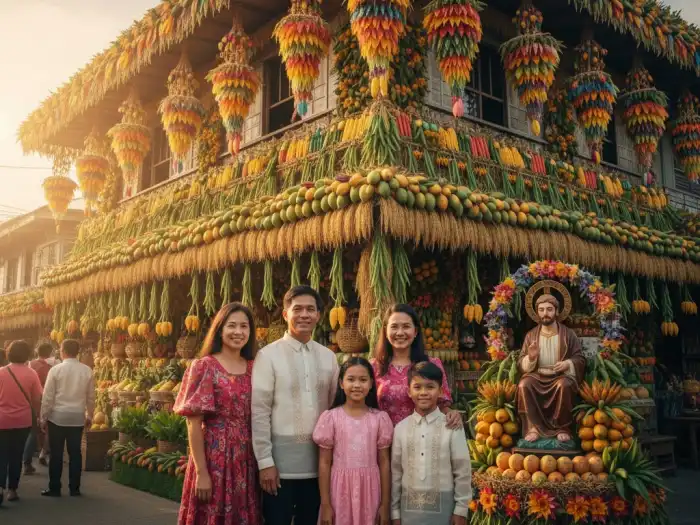
🌸 Witness Gratitude Come to Life in Lucban
The Pahiyas Festival 2026 isn’t just a feast for the eyes – it’s a living prayer of gratitude. Every kiping leaf, every rice grain glued to a wall, and every laugh shared in the streets carries a message of thanks for life’s blessings.
If you’ve never seen Lucban in May, it’s time. Walk through its narrow streets, feel the heat of the morning sun bounce off bright colors, and listen to the sound of church bells mixing with music and chatter. That’s the soul of Pahiyas – not just beauty, but belonging.
Book your trip early, come hungry, and keep your heart open. Because in Lucban, you won’t just see art – you’ll feel the faith, joy, and unity of a town that knows how to turn gratitude into celebration. 🌾✨
🧭 References
- Wikipedia – Pahiyas Festival
- Globe.com.ph – Your All-in-One Guide to the Pahiyas Festival
- Wanderlust Magazine – Pahiyas Festival (Lucban, Quezon)
- Philippine News Agency (PNA) – Memories of Lucban’s “Pahiyas Festival”
- Culture Trip – Pahiyas: The Philippines’ Most Colourful Harvest Festival



